Abstract
BACKGROUND: In healthy subjects, continuous infusions of high dose ranitidine and omeprazole produce high intragastric pH values. AIM: To test the hypothesis that both drugs also maintain high intragastric pH values in patients with bleeding ulcers. PATIENTS AND METHODS: In two parallel studies, 20 patients with bleeding duodenal ulcers and 20 patients with bleeding gastric ulcers were randomly assigned to receive either ranitidine (0.25 mg/kg/hour after a bolus of 50 mg) or omeprazole (8 mg/hour after a bolus of 80 mg) for 24 hours. Intragastric pH was continuously recorded with a glass electrode placed 5 cm below the cardia. RESULTS: Both drugs rapidly raised the intragastric pH above 6. During the second 12 hour period, however, the percentage of time spent below a pH of 6 was 0.15% with omeprazole and 20.1% with ranitidine (p = 0.0015) in patients with duodenal ulcer; in patients with gastric ulcer it was 0.1% with omeprazole and 46.1% with ranitidine (p = 0.002). CONCLUSIONS: Primed infusions of omeprazole after a bolus produced consistently high intragastric pH values in patients with bleeding peptic ulcers, whereas primed infusions with ranitidine were less effective during the second half of a 24 hour treatment course. This loss of effectiveness may be due to tolerance.
Full text
PDF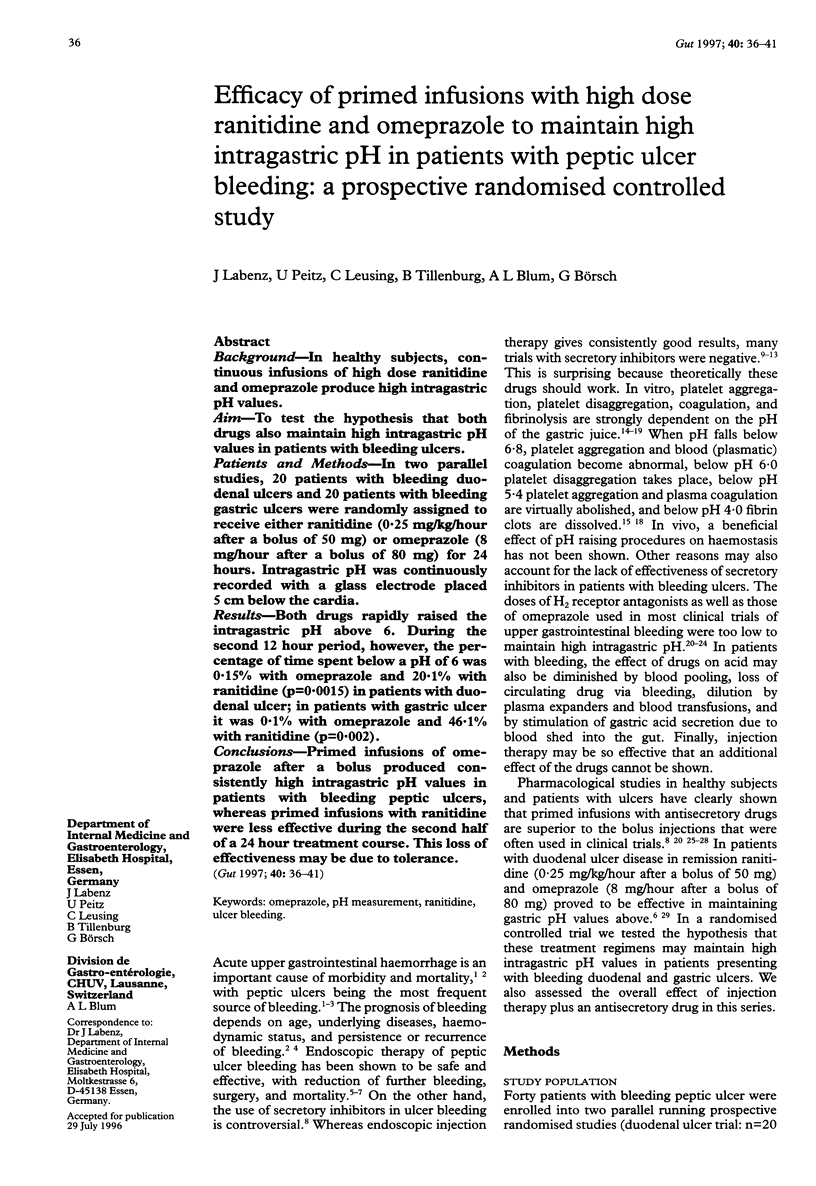
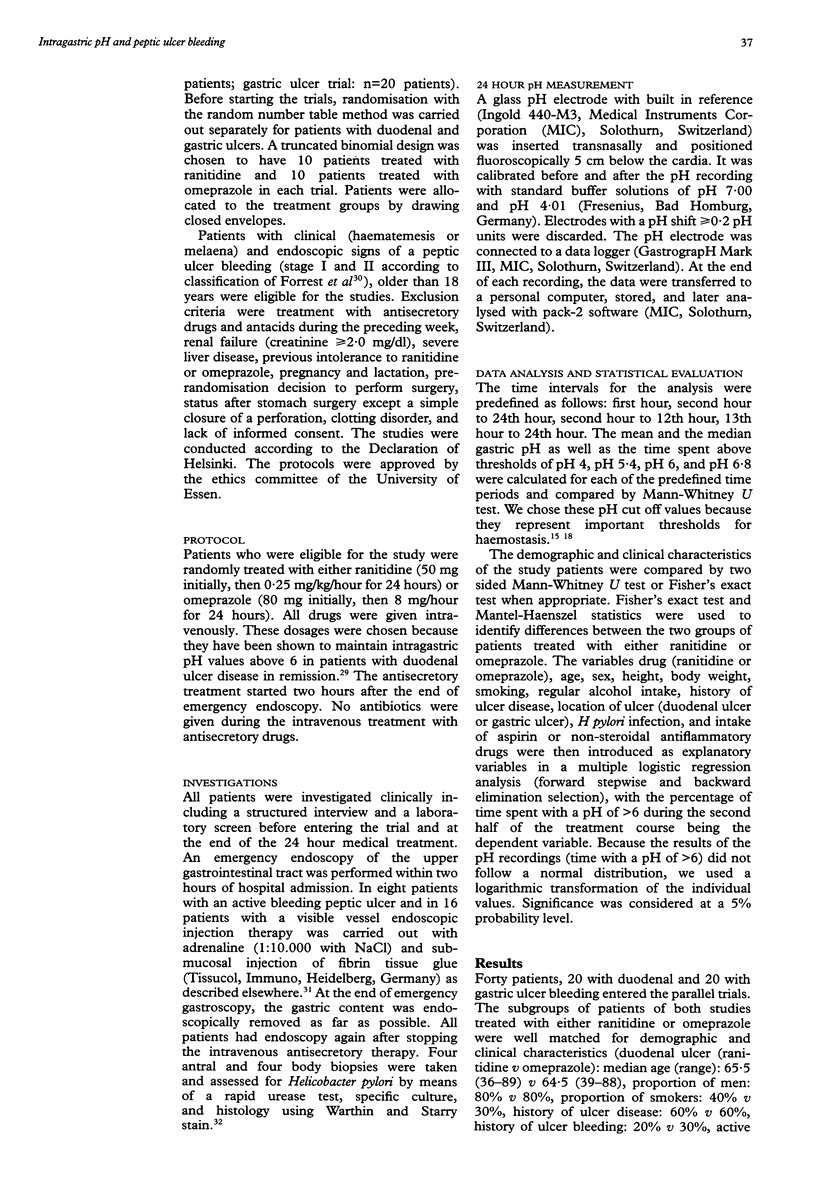
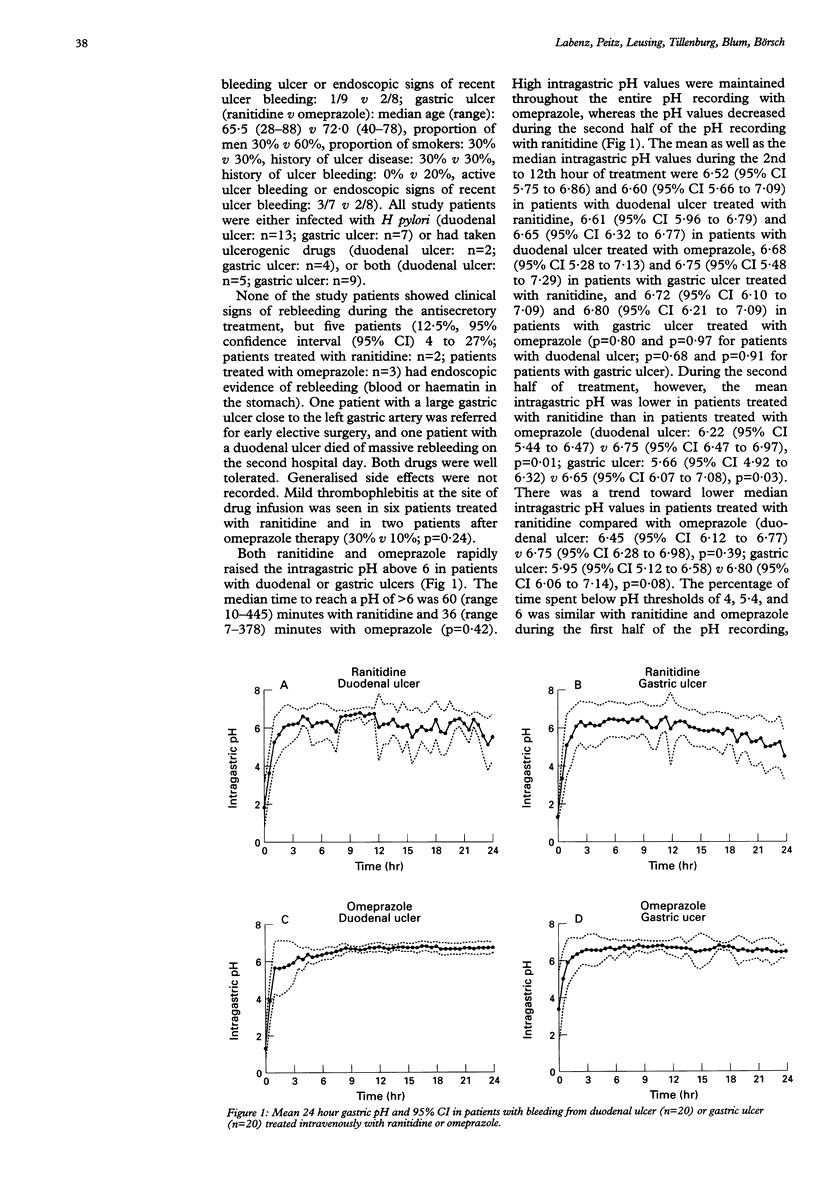

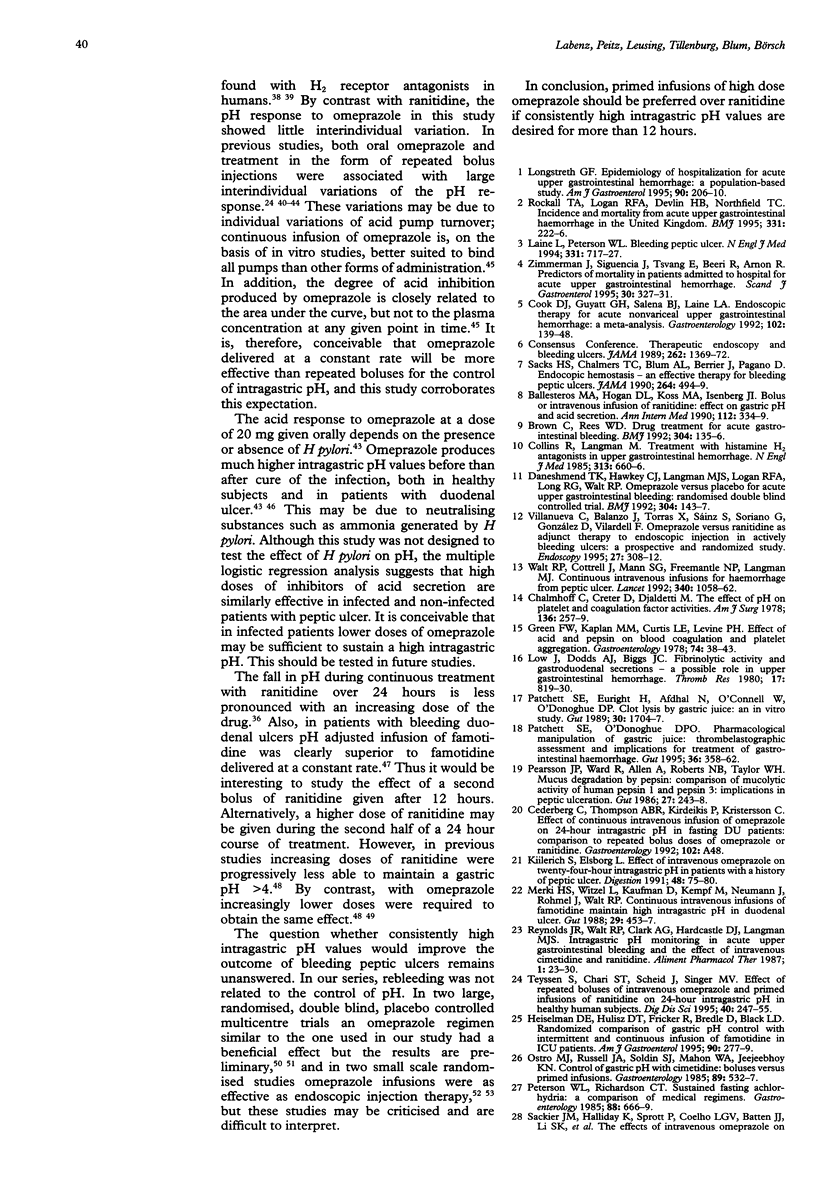
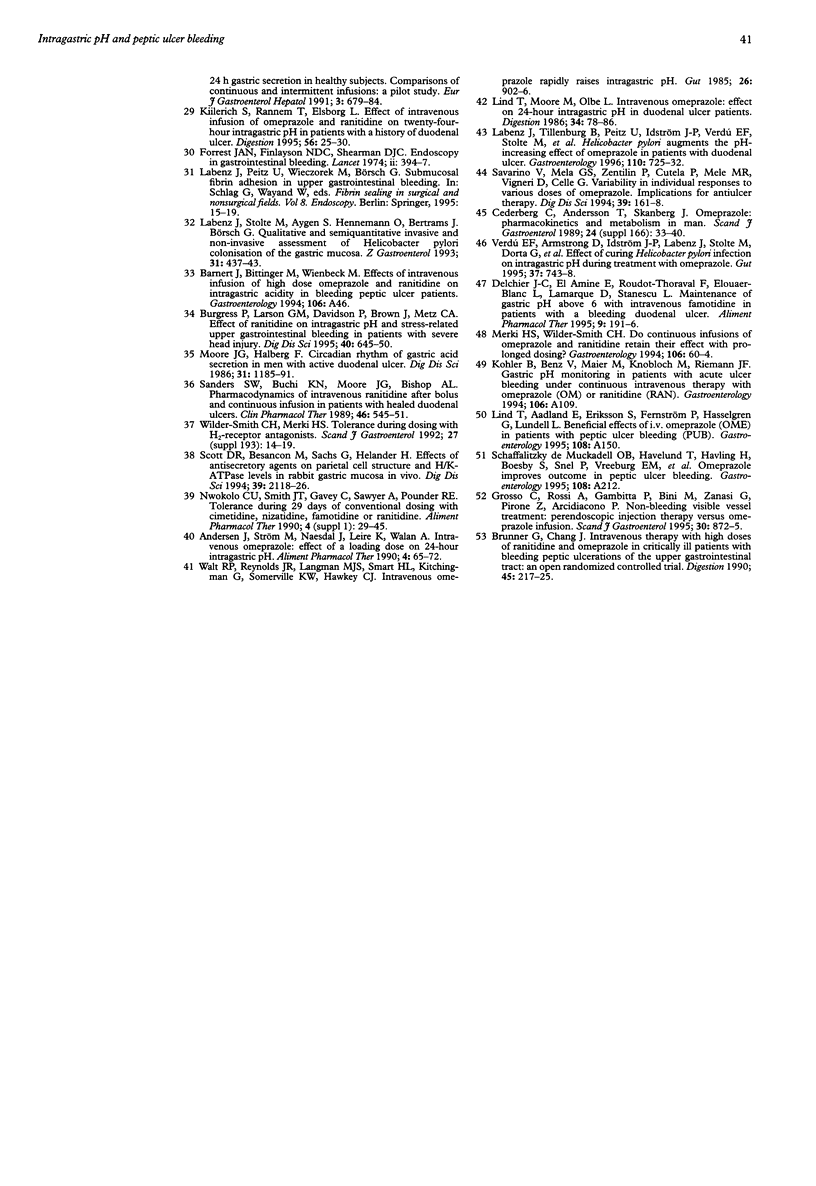
Selected References
These references are in PubMed. This may not be the complete list of references from this article.
- Andersen J., Ström M., Naesdal J., Leire K., Walan A. Intravenous omeprazole: effect of a loading dose on 24-h intragastric pH. Aliment Pharmacol Ther. 1990 Feb;4(1):65–72. doi: 10.1111/j.1365-2036.1990.tb00450.x. [DOI] [PubMed] [Google Scholar]
- Ballesteros M. A., Hogan D. L., Koss M. A., Isenberg J. I. Bolus or intravenous infusion of ranitidine: effects on gastric pH and acid secretion. A comparison of relative efficacy and cost. Ann Intern Med. 1990 Mar 1;112(5):334–339. doi: 10.7326/0003-4819-112-5-334. [DOI] [PubMed] [Google Scholar]
- Brown C., Rees W. D. Drug treatment for acute upper gastrointestinal bleeding. BMJ. 1992 Jan 18;304(6820):135–136. doi: 10.1136/bmj.304.6820.135. [DOI] [PMC free article] [PubMed] [Google Scholar]
- Brunner G., Chang J. Intravenous therapy with high doses of ranitidine and omeprazole in critically ill patients with bleeding peptic ulcerations of the upper intestinal tract: an open randomized controlled trial. Digestion. 1990;45(4):217–225. doi: 10.1159/000200249. [DOI] [PubMed] [Google Scholar]
- Burgess P., Larson G. M., Davidson P., Brown J., Metz C. A. Effect of ranitidine on intragastric pH and stress-related upper gastrointestinal bleeding in patients with severe head injury. Dig Dis Sci. 1995 Mar;40(3):645–650. doi: 10.1007/BF02064385. [DOI] [PubMed] [Google Scholar]
- Cederberg C., Andersson T., Skånberg I. Omeprazole: pharmacokinetics and metabolism in man. Scand J Gastroenterol Suppl. 1989;166:33–42. doi: 10.3109/00365528909091241. [DOI] [PubMed] [Google Scholar]
- Chaimoff C., Creter D., Djaldetti M. The effect of pH on platelet and coagulation factor activities. Am J Surg. 1978 Aug;136(2):257–259. doi: 10.1016/0002-9610(78)90241-6. [DOI] [PubMed] [Google Scholar]
- Collins R., Langman M. Treatment with histamine H2 antagonists in acute upper gastrointestinal hemorrhage. Implications of randomized trials. N Engl J Med. 1985 Sep 12;313(11):660–666. doi: 10.1056/NEJM198509123131104. [DOI] [PubMed] [Google Scholar]
- Cook D. J., Guyatt G. H., Salena B. J., Laine L. A. Endoscopic therapy for acute nonvariceal upper gastrointestinal hemorrhage: a meta-analysis. Gastroenterology. 1992 Jan;102(1):139–148. doi: 10.1016/0016-5085(92)91793-4. [DOI] [PubMed] [Google Scholar]
- Daneshmend T. K., Hawkey C. J., Langman M. J., Logan R. F., Long R. G., Walt R. P. Omeprazole versus placebo for acute upper gastrointestinal bleeding: randomised double blind controlled trial. BMJ. 1992 Jan 18;304(6820):143–147. doi: 10.1136/bmj.304.6820.143. [DOI] [PMC free article] [PubMed] [Google Scholar]
- Delchier J. C., el Amine I., Roudot-Thoraval F., Elouaer-Blanc L., Lamarque D., Stanescu L. Maintenance of gastric pH above 6 with intravenous famotidine in patients with a bleeding duodenal ulcer. Aliment Pharmacol Ther. 1995 Apr;9(2):191–196. doi: 10.1111/j.1365-2036.1995.tb00370.x. [DOI] [PubMed] [Google Scholar]
- Delchier J. C., el Amine I., Roudot-Thoraval F., Elouaer-Blanc L., Lamarque D., Stanescu L. Maintenance of gastric pH above 6 with intravenous famotidine in patients with a bleeding duodenal ulcer. Aliment Pharmacol Ther. 1995 Apr;9(2):191–196. doi: 10.1111/j.1365-2036.1995.tb00370.x. [DOI] [PubMed] [Google Scholar]
- Forrest J. A., Finlayson N. D., Shearman D. J. Endoscopy in gastrointestinal bleeding. Lancet. 1974 Aug 17;2(7877):394–397. doi: 10.1016/s0140-6736(74)91770-x. [DOI] [PubMed] [Google Scholar]
- Green F. W., Jr, Kaplan M. M., Curtis L. E., Levine P. H. Effect of acid and pepsin on blood coagulation and platelet aggregation. A possible contributor prolonged gastroduodenal mucosal hemorrhage. Gastroenterology. 1978 Jan;74(1):38–43. [PubMed] [Google Scholar]
- Grosso C., Rossi A., Gambitta P., Bini M., Zanasi G., Pirone Z., Arcidiacono R. Non-bleeding visible vessel treatment: perendoscopic injection therapy versus omeprazole infusion. Scand J Gastroenterol. 1995 Sep;30(9):872–875. doi: 10.3109/00365529509101593. [DOI] [PubMed] [Google Scholar]
- Heiselman D. E., Hulisz D. T., Fricker R., Bredle D. L., Black L. D. Randomized comparison of gastric pH control with intermittent and continuous intravenous infusion of famotidine in ICU patients. Am J Gastroenterol. 1995 Feb;90(2):277–279. [PubMed] [Google Scholar]
- Kiilerich S., Elsborg L. Effect of intravenous omeprazole on twenty-four-hour intragastric pH in patients with a history of peptic ulcer. Comparison of two four-dosage regimens. Digestion. 1991;48(2):75–80. doi: 10.1159/000200676. [DOI] [PubMed] [Google Scholar]
- Kiilerich S., Rannem T., Elsborg L. Effect of intravenous infusion of omeprazole and ranitidine on twenty-four-hour intragastric pH in patients with a history of duodenal ulcer. Digestion. 1995;56(1):25–30. doi: 10.1159/000201217. [DOI] [PubMed] [Google Scholar]
- Labenz J., Stolte M., Aygen S., Hennemann O., Bertrams J., Börsch G. Qualitative und semiquantitative invasive und nicht-invasive Diagnostik der Helicobacter pylori-Kolonisation der gastralen Mukosa. Z Gastroenterol. 1993 Jul-Aug;31(7-8):437–443. [PubMed] [Google Scholar]
- Labenz J., Tillenburg B., Peitz U., Idström J. P., Verdú E. F., Stolte M., Börsch G., Blum A. L. Helicobacter pylori augments the pH-increasing effect of omeprazole in patients with duodenal ulcer. Gastroenterology. 1996 Mar;110(3):725–732. doi: 10.1053/gast.1996.v110.pm8608881. [DOI] [PubMed] [Google Scholar]
- Laine L., Peterson W. L. Bleeding peptic ulcer. N Engl J Med. 1994 Sep 15;331(11):717–727. doi: 10.1056/NEJM199409153311107. [DOI] [PubMed] [Google Scholar]
- Lind T., Moore M., Olbe L. Intravenous omeprazole: effect on 24-hour intragastric pH in duodenal ulcer patients. Digestion. 1986;34(2):78–86. doi: 10.1159/000199314. [DOI] [PubMed] [Google Scholar]
- Longstreth G. F. Epidemiology of hospitalization for acute upper gastrointestinal hemorrhage: a population-based study. Am J Gastroenterol. 1995 Feb;90(2):206–210. [PubMed] [Google Scholar]
- Low J., Dodds A. J., Biggs J. C. Fibrinolytic activity of gastroduodenal secretions--a possible role in upper gastrointestinal haemorrhage. Thromb Res. 1980 Mar 15;17(6):819–830. doi: 10.1016/0049-3848(80)90247-9. [DOI] [PubMed] [Google Scholar]
- Merki H. S., Wilder-Smith C. H. Do continuous infusions of omeprazole and ranitidine retain their effect with prolonged dosing? Gastroenterology. 1994 Jan;106(1):60–64. doi: 10.1016/s0016-5085(94)94341-9. [DOI] [PubMed] [Google Scholar]
- Merki H. S., Witzel L., Kaufman D., Kempf M., Neumann J., Röhmel J., Walt R. P. Continuous intravenous infusions of famotidine maintain high intragastric pH in duodenal ulcer. Gut. 1988 Apr;29(4):453–457. doi: 10.1136/gut.29.4.453. [DOI] [PMC free article] [PubMed] [Google Scholar]
- Moore J. G., Halberg F. Circadian rhythm of gastric acid secretion in men with active duodenal ulcer. Dig Dis Sci. 1986 Nov;31(11):1185–1191. doi: 10.1007/BF01296516. [DOI] [PubMed] [Google Scholar]
- Nwokolo C. U., Smith J. T., Gavey C., Sawyerr A., Pounder R. E. Tolerance during 29 days of conventional dosing with cimetidine, nizatidine, famotidine or ranitidine. Aliment Pharmacol Ther. 1990;4 (Suppl 1):29–45. [PubMed] [Google Scholar]
- Ostro M. J., Russell J. A., Soldin S. J., Mahon W. A., Jeejeebhoy K. N. Control of gastric pH with cimetidine: boluses versus primed infusions. Gastroenterology. 1985 Sep;89(3):532–537. doi: 10.1016/0016-5085(85)90447-0. [DOI] [PubMed] [Google Scholar]
- Patchett S. E., Enright H., Afdhal N., O'Connell W., O'Donoghue D. P. Clot lysis by gastric juice: an in vitro study. Gut. 1989 Dec;30(12):1704–1707. doi: 10.1136/gut.30.12.1704. [DOI] [PMC free article] [PubMed] [Google Scholar]
- Patchett S. E., O'Donoghue D. P. Pharmacological manipulation of gastric juice: thrombelastographic assessment and implications for treatment of gastrointestinal haemorrhage. Gut. 1995 Mar;36(3):358–362. doi: 10.1136/gut.36.3.358. [DOI] [PMC free article] [PubMed] [Google Scholar]
- Pearson J. P., Ward R., Allen A., Roberts N. B., Taylor W. H. Mucus degradation by pepsin: comparison of mucolytic activity of human pepsin 1 and pepsin 3: implications in peptic ulceration. Gut. 1986 Mar;27(3):243–248. doi: 10.1136/gut.27.3.243. [DOI] [PMC free article] [PubMed] [Google Scholar]
- Peterson W. L., Richardson C. T. Sustained fasting achlorhydria: a comparison of medical regimens. Gastroenterology. 1985 Mar;88(3):666–669. doi: 10.1016/0016-5085(85)90134-9. [DOI] [PubMed] [Google Scholar]
- Reynolds J. R., Walt R. P., Clark A. G., Hardcastle J. D., Langman M. J. Intragastric pH monitoring in acute upper gastrointestinal bleeding and the effect of intravenous cimetidine and ranitidine. Aliment Pharmacol Ther. 1987 Feb;1(1):23–30. doi: 10.1111/j.1365-2036.1987.tb00602.x. [DOI] [PubMed] [Google Scholar]
- Rockall T. A., Logan R. F., Devlin H. B., Northfield T. C. Incidence of and mortality from acute upper gastrointestinal haemorrhage in the United Kingdom. Steering Committee and members of the National Audit of Acute Upper Gastrointestinal Haemorrhage. BMJ. 1995 Jul 22;311(6999):222–226. doi: 10.1136/bmj.311.6999.222. [DOI] [PMC free article] [PubMed] [Google Scholar]
- Sacks H. S., Chalmers T. C., Blum A. L., Berrier J., Pagano D. Endoscopic hemostasis. An effective therapy for bleeding peptic ulcers. JAMA. 1990 Jul 25;264(4):494–499. doi: 10.1001/jama.264.4.494. [DOI] [PubMed] [Google Scholar]
- Sanders S. W., Buchi K. N., Moore J. G., Bishop A. L. Pharmacodynamics of intravenous ranitidine after bolus and continuous infusion in patients with healed duodenal ulcers. Clin Pharmacol Ther. 1989 Nov;46(5):545–551. doi: 10.1038/clpt.1989.184. [DOI] [PubMed] [Google Scholar]
- Savarino V., Mela G. S., Zentilin P., Cutela P., Mele M. R., Vigneri S., Celle G. Variability in individual response to various doses of omeprazole. Implications for antiulcer therapy. Dig Dis Sci. 1994 Jan;39(1):161–168. doi: 10.1007/BF02090077. [DOI] [PubMed] [Google Scholar]
- Scott D. R., Besancon M., Sachs G., Helander H. Effects of antisecretory agents on parietal cell structure and H/K-ATPase levels in rabbit gastric mucosa in vivo. Dig Dis Sci. 1994 Oct;39(10):2118–2126. doi: 10.1007/BF02090359. [DOI] [PubMed] [Google Scholar]
- Teyssen S., Chari S. T., Scheid J., Singer M. V. Effect of repeated boluses of intravenous omeprazole and primed infusions of ranitidine on 24-hour intragastric pH in healthy human subjects. Dig Dis Sci. 1995 Feb;40(2):247–255. doi: 10.1007/BF02065405. [DOI] [PubMed] [Google Scholar]
- Verdú E. F., Armstrong D., Idström J. P., Labenz J., Stolte M., Dorta G., Börsch G., Blum A. L. Effect of curing Helicobacter pylori infection on intragastric pH during treatment with omeprazole. Gut. 1995 Dec;37(6):743–748. doi: 10.1136/gut.37.6.743. [DOI] [PMC free article] [PubMed] [Google Scholar]
- Villanueva C., Balanzó J., Torras X., Sáinz S., Soriano G., González D., Vilardell F. Omeprazole versus ranitidine as adjunct therapy to endoscopic injection in actively bleeding ulcers: a prospective and randomized study. Endoscopy. 1995 May;27(4):308–312. doi: 10.1055/s-2007-1005698. [DOI] [PubMed] [Google Scholar]
- Walt R. P., Cottrell J., Mann S. G., Freemantle N. P., Langman M. J. Continuous intravenous famotidine for haemorrhage from peptic ulcer. Lancet. 1992 Oct 31;340(8827):1058–1062. doi: 10.1016/0140-6736(92)93078-2. [DOI] [PubMed] [Google Scholar]
- Walt R. P., Reynolds J. R., Langman M. J., Smart H. L., Kitchingman G., Somerville K. W., Hawkey C. J. Intravenous omeprazole rapidly raises intragastric pH. Gut. 1985 Sep;26(9):902–906. doi: 10.1136/gut.26.9.902. [DOI] [PMC free article] [PubMed] [Google Scholar]
- Wilder-Smith C. H., Merki H. S. Tolerance during dosing with H2-receptor antagonists. An overview. Scand J Gastroenterol Suppl. 1992;193:14–19. doi: 10.3109/00365529209096000. [DOI] [PubMed] [Google Scholar]
- Zimmerman J., Siguencia J., Tsvang E., Beeri R., Arnon R. Predictors of mortality in patients admitted to hospital for acute upper gastrointestinal hemorrhage. Scand J Gastroenterol. 1995 Apr;30(4):327–331. doi: 10.3109/00365529509093285. [DOI] [PubMed] [Google Scholar]


